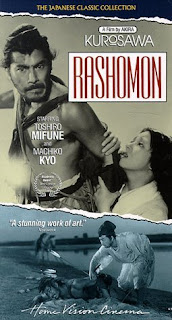
I don't have to repeat that Rashomon's strength is its screenplay. The same event is recounted by four people and each version is widely different from the rest. A samurai, his wife, a bandit and a woodcutter provide their versions of a rape and the subsequent murder in a jungle. Since each narrator is a stakeholder in the event, his or her version is clouded by ego, fear and self-interest. As a result, each version diverges from the truth and at various points each version contradicts the rest [The woodcutter's version is the least biased]. I read a lot of reviews concluding that Rashomon is about "subjectivity of truth" or "perception of truth". In my opinion, these terms take the philosophy of Rashomon a little too far. To me, this film is simply about how an individual's account of an event can be influenced by his emotions.
Digressing a little bit, I recall that back in 2004, I watched a tamil movie, Virumandi, that left me gaping for its unique narrative. I also happened to watch Vantage point that had a similar narrative style. For a long time, I did not know that this style had a term, eponymous of Rashomon. Since I had watched two movies with similar narrative style, I was reasonably used to it while watching Rashomon. I am sure people would have jumped out of their seats when they first watched it back in the fifties.
Talking about cast, there are only eight actors, including Toshiro Mifune and Takashi Shimura. Toshiro Mifune excels once again as he conveys a range of emotions: anger, fear, lust, relief, confusion, suspicion, excitement, etc. To a large extent, Mifune's Tajomaru is similar to his Kikuchiyo from Seven Samurai. He is boorish, fierce and athletic. The rest of the cast also does very well. There is one particular scene where Masayuki Mori, as the samurai husband, stands out. And that is during the wife's narration where his expressions are filled with derision. That scene does leave an impression.
Rashomon has excellent cinematography and background music. A simple scene is case in point here. Takashi Shimura walks through the dense jungles amidst huge overshadowing trees on a bright afternoon. While watching the movie, one can easily forget that this stroll runs for a full two minutes without any drama. The heavy background music combined with arresting visuals keeps the viewer engrossed as he knows that something is brooding out there. As an editor, Akira Kurosawa has stitched the visuals and sound perfectly. One scene that highlights the quality of editing is towards the very end when the priest holds the weeping infant [Ahh... here is one guy who is not credited in the cast]. The drop in pitch in each cry of the infant perfectly syncs with its movements. I wonder how they captured the sound so perfectly, or was it the magic of editing?? Considering the days when it was shot, even the make-up looks realistic. Most of the men have sported natural beard and the hairpieces almost look natural.
To conclude, this film is Kurosawa's yet another timeless classic, which will be best remembered for "Rashomon Effect".
